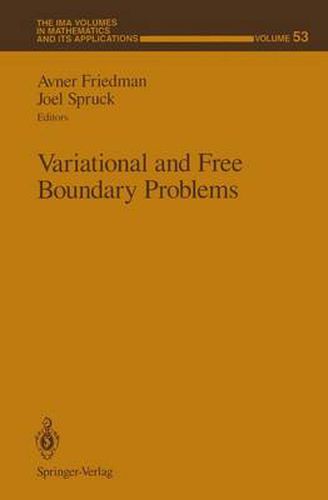Readings Newsletter
Become a Readings Member to make your shopping experience even easier.
Sign in or sign up for free!
You’re not far away from qualifying for FREE standard shipping within Australia
You’ve qualified for FREE standard shipping within Australia
The cart is loading…






This title is printed to order. This book may have been self-published. If so, we cannot guarantee the quality of the content. In the main most books will have gone through the editing process however some may not. We therefore suggest that you be aware of this before ordering this book. If in doubt check either the author or publisher’s details as we are unable to accept any returns unless they are faulty. Please contact us if you have any questions.
This IMA Volume in Mathematics and its Applications VARIATIONAL AND FREE BOUNDARY PROBLEMS is based on the proceedings of a workshop which was an integral part of the 1990- 91 IMA program on Phase Transitions and Free Boundaries.
The aim of the workshop was to highlight new methods, directions and problems in variational and free boundary theory, with a concentration on novel applications of variational methods to applied problems. We thank R. Fosdick, M. E. Gurtin, W. -M. Ni and L. A. Peletier for organizing the year-long program and, especially, J. Sprock for co-organizing the meeting and co-editing these proceedings. We also take this opportunity to thank the National Science Foundation whose financial support made the workshop possible. Avner Friedman Willard Miller, Jr. PREFACE In a free boundary one seeks to find a solution u to a partial differential equation in a domain, a part r of its boundary of which is unknown. Thus both u and r must be determined. In addition to the standard boundary conditions on the un known domain, an additional condition must be prescribed on the free boundary. A classical example is the Stefan problem of melting of ice; here the temperature sat isfies the heat equation in the water region, and yet this region itself (or rather the ice-water interface) is unknown and must be determined together with the tempera ture within the water. Some free boundary problems lend themselves to variational formulation.
$9.00 standard shipping within Australia
FREE standard shipping within Australia for orders over $100.00
Express & International shipping calculated at checkout
This title is printed to order. This book may have been self-published. If so, we cannot guarantee the quality of the content. In the main most books will have gone through the editing process however some may not. We therefore suggest that you be aware of this before ordering this book. If in doubt check either the author or publisher’s details as we are unable to accept any returns unless they are faulty. Please contact us if you have any questions.
This IMA Volume in Mathematics and its Applications VARIATIONAL AND FREE BOUNDARY PROBLEMS is based on the proceedings of a workshop which was an integral part of the 1990- 91 IMA program on Phase Transitions and Free Boundaries.
The aim of the workshop was to highlight new methods, directions and problems in variational and free boundary theory, with a concentration on novel applications of variational methods to applied problems. We thank R. Fosdick, M. E. Gurtin, W. -M. Ni and L. A. Peletier for organizing the year-long program and, especially, J. Sprock for co-organizing the meeting and co-editing these proceedings. We also take this opportunity to thank the National Science Foundation whose financial support made the workshop possible. Avner Friedman Willard Miller, Jr. PREFACE In a free boundary one seeks to find a solution u to a partial differential equation in a domain, a part r of its boundary of which is unknown. Thus both u and r must be determined. In addition to the standard boundary conditions on the un known domain, an additional condition must be prescribed on the free boundary. A classical example is the Stefan problem of melting of ice; here the temperature sat isfies the heat equation in the water region, and yet this region itself (or rather the ice-water interface) is unknown and must be determined together with the tempera ture within the water. Some free boundary problems lend themselves to variational formulation.